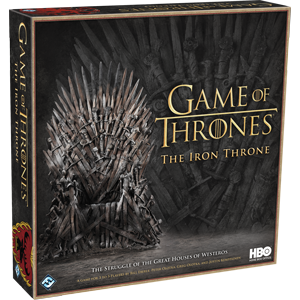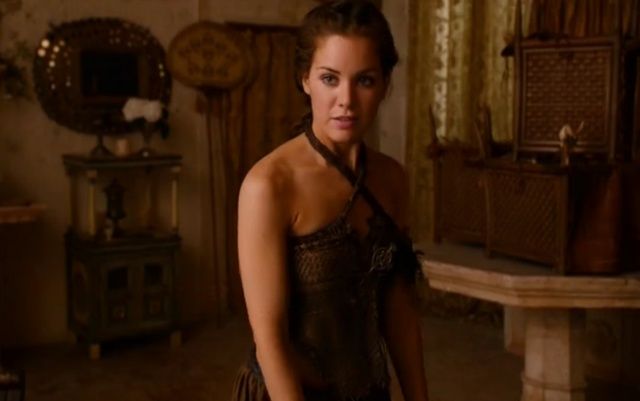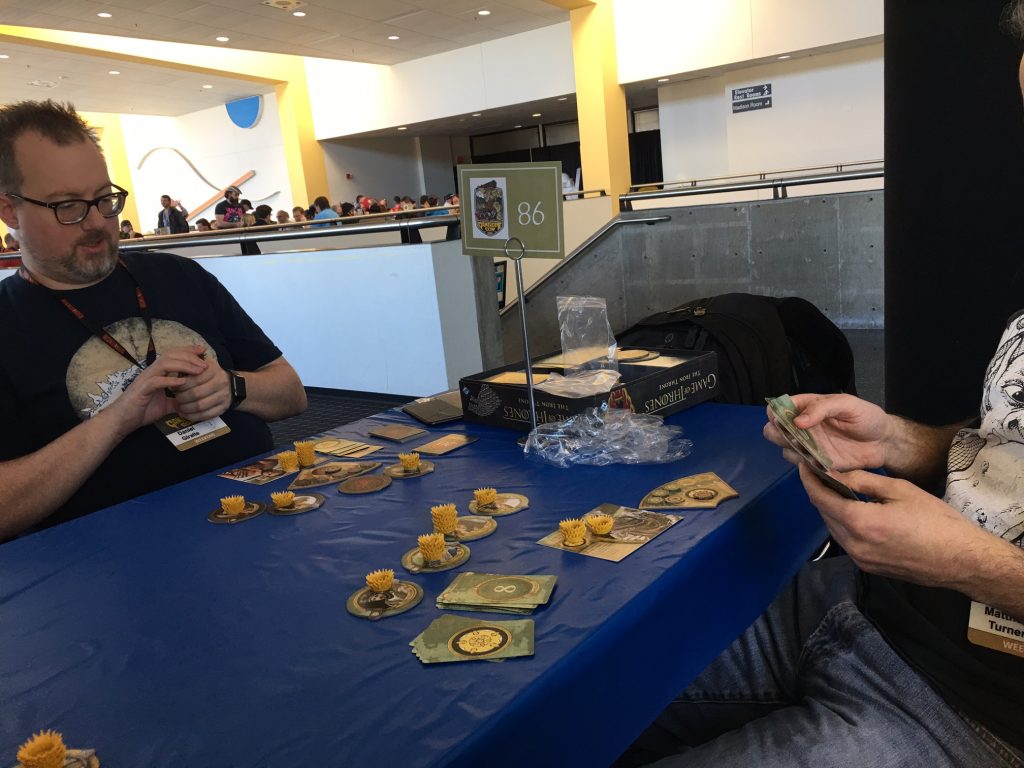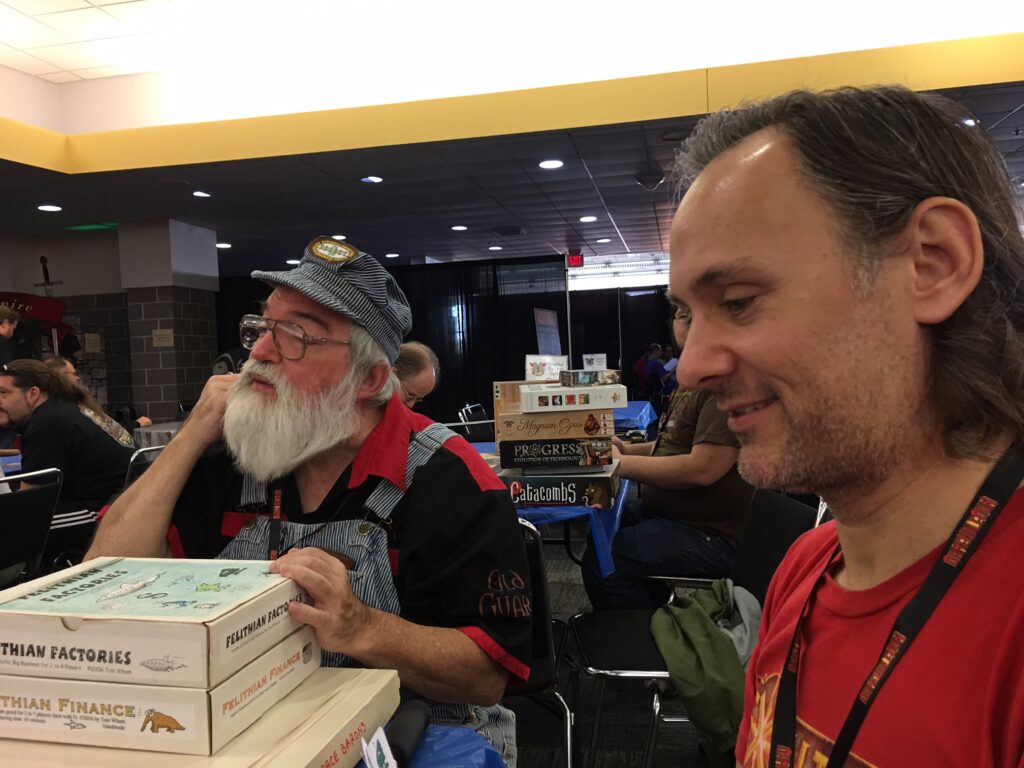Gamehole con in Madison is growing. Though a local Wisconsin con, it’s very professionally run an organized, with good swag and lots and lots of gaming. This year was definitely bigger than last year. It seemed a little crowded last year, but it was actually crowded this year. We were there on Friday and Saturday for most of the day. We got in a meh 5E game (it was for new players, so we probably should not have signed up) and a game of the new Game of Thrones: Iron Throne FF game on Friday. Saturday was all Tom Wham, with 2 games of Felician Finance and a 5-player game of Feudality (with my 6 year old kid). I got some food poisoning on Friday night, so felt like shit for part of it. The food trucks at the con were great (I don’t think my food poisoning was from them).

Game of Thrones: Iron Throne
Matt picked this up the day it came out in stores. Iron Throne differs from FF’s CCG and strategy board game takes on the game in that it uses a modified version of Cosmic Encounter to resolve the conflict in Westeros. It’s not heavily modified, so Cosmic Encounter players will have little problems picking it up. People that have never played CE before may have a bit of a brain shift as there is no map to fight over and the win conditions are different from many of the other GoT games.
How does it play? We got in a single game on Friday and I can speak to the changes from CE but not too much on how a big 5 player knock-down drag out game will be as we only had 3 players. First, your planets in Iron Throne are your characters and they can get killed. Second, you have a faction and a leader of that faction chosen from your characters. Depending on the leader, your faction will have a different uber power.
Unlike CE, your goal is not to put your influence on characters (planets) but spread all 5 of your influence to other player’s faction boards. While this is similar to CE, it’s worth noting that, as far as I can tell, there is no way to remove influence once it’s placed.
Characters each have 4 power on them to start (like CE ships). This can go down and up, but unlike CE, if the power on a character ever goes to zero, that character is out of the game. They can no longer attack or participate and their character cards in your deck only count as a zero attack card. Power flows back and forth from the faction’s leader to the character based on what’s happening in the game. Factions usually have 24 power between the leader and characters, but this can change.

The Flares from Cosmic are now included in a faction specific deck that each player has. The faction deck has your attack and negotiate (called Truce) cards like CE, but has a set of what are essentially Flare cards that are tied to each character in your faction. Each attack of defense must involve one of your characters, and in each encounter, you can play that character’s ‘flare’ card, or that of your leader, to effect the outcome. The powers on the cards are pretty wild. My favorite during the game (as Baratheon) was the Onion Knight who allowed me to change my played card for any attack card in my hand instead.
Other than picking your faction, you have to choose one of that faction’s characters as your leader. That character cannot die, and his or her ‘flare’ cards are always playable. The rest of your leaders can be killed during the game.
Challenges work similar to CE with some subtle differences. Offensive and Defensive allies can choose to join either side with one of their characters, and the helped player can decline the help (rather than the other way around in CE). Attack cards and Negotiate cards are in the game, but no other types (no Kickers for example). The number range caps out at 20, and doesn’t hit the higher numbers like 30 and 40 that CE does. This means that what you bring in terms of character power is a lot more important at times than the cards played.
Truces and Negotiation work a bit differently in Iron Throne as well. If your opponent plays an attack card and you tried a Truce, you lose but you get to take a hostage from all the players on the winning side.
Hostages are cards taken from another players hand or their deck. Sometimes you will get trash, but other times you will grab a character card or one of the high attack cards. In our game, Dan was sitting on Matt’s 20 attack card the whole game. Hostages can be traded as part of a deal or any type of discussion. Hostage character cards give leverage over characters, as they can be used to do 4 damage to that character, which in most cases will take that character out of the game. This is good to do to the clear leader, but in Iron Throne, as in CE, your enemy today will be your friend tomorrow, so ham-stringing a potential ally later in the game may not be the best idea.

There are also mechanics to reduce a factions overall power by cutting down the crowns that they have in their pool, either on their leader or on their characters. This is a bit like removing ships from a game of CE, except it has the added effect of making characters more vulnerable to being killed.
The main factions are all represented in the game, and there is a good sense of asymmetry with the leaders and the different flare cards that characters have. This is not as variable as CE, but I think that’s just fine. The factions are internally diverse, with 5 potential leaders within each faction (so about 25 ‘aliens’ included in the game). No, it’s not a new DUNE, but Iron Throne is a keeper.
Felithian Finance
We got in on one of Tom Wham’s game sessions during the con and played Felithian Finance. Great game, should be officially published! It’s essentially a stock market game which seems super boring to even imagine, but it’s not. It reminds me of a goofy version of Sid Sackson’s Acquire with a lot more randomness and fun. Where Tigris took Acquire’s concept to mechanical perfection, Felitihan takes the abstract concept of ‘companies on a grid’ and turns it into something definitely Wham-esque.
The basic play is buying stock (secret or open) and then starting or increasing the size of companies on a board. Dice are rolled and if the number comes up on top of a company, it starts paying dividends. Players get the stock price (which they control to some extent) and dividends (which they don’t control) at the end of the game. The game has a lot of interesting choices and is very quick for the depth– only about 45 minutes each game we played.

